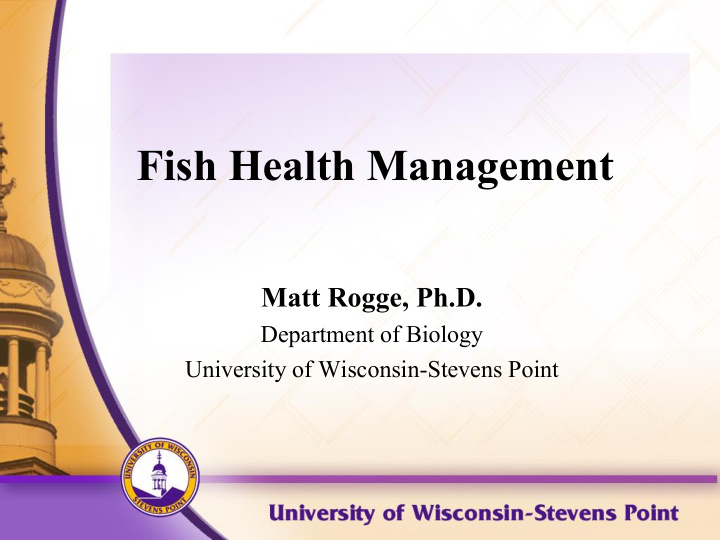



Fish Health Management Matt Rogge, Ph.D. Department of Biology University of Wisconsin-Stevens Point
Overview of Talk • Introduction to fish health • Types of disease – Dietary – Water Quality – Infectious • Signs of disease http://www.ag.auburn.edu/fish/image_gallery/data/media/61/ESC.jpg • Diagnosis and treatment
Fish Health • Health of fish is dependent on many factors – Environmental conditions • Quality of diet • Stocking density • Quality of water – Sources and types of pathogens – Species/strain of fish http://www.climatesignals.org/sites/www.climatesignals.org/files/ reports/venn_diagram.png
Feed • Use a species-appropriate high quality feed • Different formulations for different life stages – Starter feed – Fingerling feed – Grow-out feed • Nutritional deficiencies lead to growth defects, internal organ dysfunction, anemia, etc. • Poor diet can lead to immune dysfunction, resulting in increased risk of infection
Stocking Density • High density increases disease transmission • Reduces water quality • Increases stress
Water Quality • Poor water quality can – cause stress and hinder immune responses – support the growth of unwanted microbes – directly result in mortality
Water Quality Parameters • Temperature, pH, dissolved oxygen • Nitrogen – Ammonia • NH 3 /NH 4 + – Nitrite (NO 2 - ) – Nitrate (NO 3 - ) • Chlorine • Alkalinity and hardness • Dissolved gases
Nitrogen Cycle Biological filtration NH 3 / NO 2 - NO 3 - NH 4 + Bacteria are necessary!
Maintaining a Biofilter • Adequate surface area • Aeration – O 2 is required • Limited use of chemicals in the system – Disinfectants – Antibiotics – If used, the microbes need time to recover and recolonize
Infectious Agents • Fish are susceptible to various infectious agents – Bacteria – Viruses – Fungi – Parasites
Opportunistic Infectious Agents • Cause disease when fish are stressed or injured – Organisms may always be present in a system – Flavobacterium, Streptococcus • Although these organisms are present, the immune system of healthy fish prevents disease outbreaks
Primary Infectious Agents • Pathogens that infect healthy fish – Tend to cause more severe infections – Tend to be harder to treat • Prevent using strict biosecurity measures • Stressful conditions will allow these to spread faster and be harder to treat
Susceptibility of Fish to Infection • Young fish tend to be more susceptible • Some pathogens are species or strain- specific, while others infect many species • Stress increases susceptibility – Temperature, pH, water quality, etc • Nutritional deficiencies increase susceptibility
Identifying Disease in a Population • Behavior changes • Physical changes – Off feed – Lesions – Piping – Popeye – Erratic swimming – Dropsy – Lethargy – Discolored gills http://www.ag.auburn.edu/fish/mediagallery/files/2013/08/751.jpg http://ocw.tufts.edu/data/72/1362315/1369003/ 1378146_xlarge.jpg
What to Do Next • Remove any dead fish immediately • If possible quarantine sick fish • Review water quality records; check feed • Contact a veterinarian and/or submit fish to a diagnostic lab – Ship live if possible – Dead on ice is next best
Treatments • Work with a veterinarian on developing a treatment strategy – Antibiotics may work for bacterial infections • Difficult if fish are off feed – Chemical/bath treatments may work for fungal or parasitic infections • Limited approval • Impractical for pond culture
“An ounce of prevention is worth a pound of cure” • Purchase eggs/fingerlings from a reputable dealer; ensure certified pathogen-free • Vaccinate if available • Maintain proper water quality • Implement strict biosecurity measures – Disinfect equipment – Quarantine incoming fish – Limit access • Be familiar with common diseases • Train staff to recognize disease signs
Minimizing Stress • Use appropriate stocking densities • Maintain proper water conditions • Minimize handling • Maintain good water quality • Use an appropriate feed • Reduce the presence of predators
In Summary… • Fish health is dependent on many factors – Environmental – Types of pathogens – Fish species and age http://www.climatesignals.org/sites/www.climatesignals.org/files/ reports/venn_diagram.png
In Summary… • The best treatment is prevention – Quality fish – Good water quality – High quality feed – Minimize stress – Minimize cross-contamination between systems
In Summary • If abnormal mortalities occur and signs of disease are present – Consult a fish health professional – Submit specimens for diagnostic testing – Apply treatments as directed – Review biosecurity protocols
Resources • RAC Publications: https://www.ncrac.org/publications – Biosecurity: https://www.ncrac.org/files/biblio/FS115Biosecurity.pdf – Whirling disease: https://www.ncrac.org/files/biblio/Whirling2.pdf – Grubs: https://www.ncrac.org/files/biblio/TB115.pdf – Aeromonas: https://www.ncrac.org/files/biblio/SRAC0478.pdf – Columnaris: https://www.ncrac.org/files/biblio/SRAC0479b.pdf – Ich: https://www.ncrac.org/files/biblio/SRAC0476.pdf – Ammonia: https://www.ncrac.org/files/biblio/SRAC0463.pdf – Nitrite: https://www.ncrac.org/files/biblio/SRAC0462.pdf – Health management: https://www.ncrac.org/files/biblio/NRAC0111.pdf – Water chemistry: https://www.ncrac.org/files/biblio/NRAC0170.pdf – Stress: https://www.ncrac.org/files/biblio/SRAC0474.pdf
Recommend
More recommend